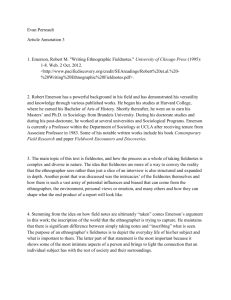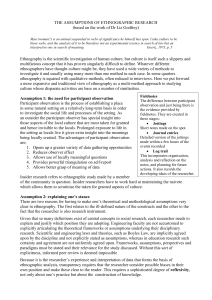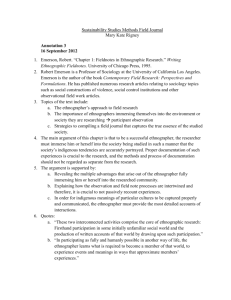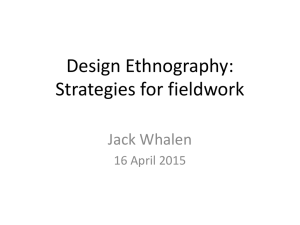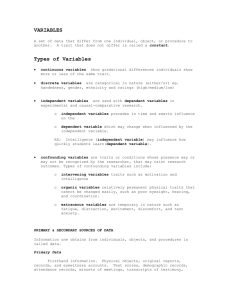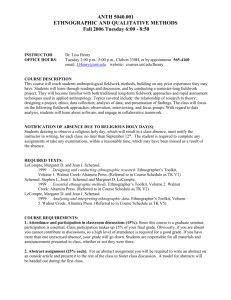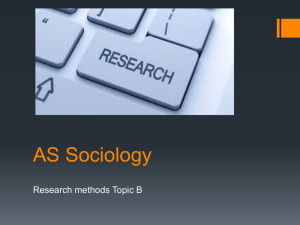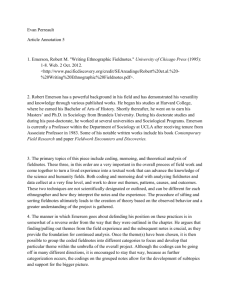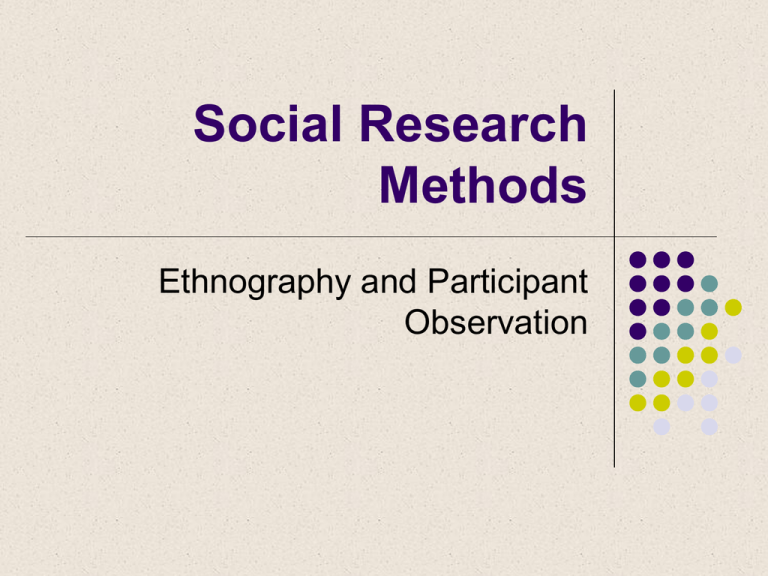
Social Research
Methods
Ethnography and Participant
Observation
Ethnography
Detailed description of events + insights into
their meaning
A method of discovery - the obscure - small
samples.
Comparative method - official/unofficial,
formal/informal
Naturalistic stance - natural setting - empathy.
Understand the symbolic world of the people
studied
Key methods
Interviews
Documents
Direct observation - become part of the
setting = Participant observation
Entering the field
Entry = the process of developing presence and
relationships in the designated research setting
that makes it possible for the researcher to
collect data.
Field = the natural, non-laboratory setting or
location where the activities in which a
researcher is interested take place.
Building rapport
Develop good personal relationships with people to
get access and information
Participant observation
= data collection technique that requires the
researcher to be present at, involved in and
recording the routine daily activities with people
in the field setting.
Identify the rules and meanings that govern
relationships and actions in the setting.
Not just observation, but often asking
questions too (if possible)
Classic examples
James Patrick - A Glasgow Gang
Observed
William Foote Whyte - Street Corner
Society
Laud Humphreys - Tearoom Trade
Erving Goffman - Asylums
Covert vs. overt
Covert - secret.
Ethical problems - justifiable if no alternative (e.g.
with elites)
May limit ability to wander (should be working)
May limit where you can go (workers not allowed in
management canteen)
Good for understanding what role means for
participants
No ethical issues if done in public arena, (football
match, shopping, club). But may still need
permission.
Overt - known
Need to negotiate access
Gatekeepers = those who control access to
information, other individuals and settings.
May also be a sponsor.
Some gain entry just by “hanging about” (e.g.
fiddling by market traders)
Local gatekeepers are people who control
access to resources or information
researchers need.
Key informants
Recognized special expertise in a topic of
interest to the researcher
cultural experts are people who have special
cultural expertise.
Gatekeeper often the first informant
BUT, beware, key informants may not be
typical people in the setting.
Front management
Impression you make in the setting
Need to get along and like people (to some
extent) even if you don’t agree with them.
The acceptable incompetent
Going native -> too much empathy
Balance view of the Martian and the convert.
Dealing with factions - align with largest
group or remain outside and neutral
Marginality
Fear of non-acceptance
Loneliness
Worry over discovery of covert status
Helps to work in a team
Marginality is creative - generates insight.
Those observed may use
exclusionary techniques
Using a standard language unfamiliar to the
researcher
Code switching (changing from a language
familiar to the researcher to one not understood)
Changing the subject of a conversation when
the ethnographer approaches
Refusing to answer the question
Positioning so that the ethnographer cannot
hear what is being said
Not inviting researchers to attend social events.
Reasons for this =
Lack of trust
Discomfort with outsider
Inability to support stranger (e.g. cannot
afford)
What to observe
Settings
Observe and track events and event
sequences
Counting, census-taking and ethnographic
mapping (e.g. decisions, kin relationships)
Searching for indicators of socio-economic
difference
Data Collection
Notes
Still camera
Audio & still camera
Video
Laptops
Tracking users:
- diaries
- interaction logging
Settings
Need to identify - talk to some participants or
research partners (gatekeepers)
Public or semi-public settings can be
observed in unobtrusive way.
Events
Involve more than one person
Have History and consequence
Are repeated
Bounded in time and space.
e.g. meetings, gatherings, celebrations,
religious, political social and sporting events,
Classic questions are
Space. What is the physical space like?
Actors. Who is involved?
Activities. What are they doing?
Objects. What objects are present?
Acts. What are individuals doing?
Events. What kind of event is it?
Goals. What do they want to accomplish?
Feelings. What is the mood of the group
and of individuals?
Counting, census-taking etc.
Cross-sectional or longitudinal
E.g. number, ages, mixture of cultures, ethnicity
etc.
E.g. how many at the club, ages, sex, style of
dress, how many in group, when they arrived?
Census = details of each household
Do this in ethnography or community study
Basic form for each. Maps of community.
Use maps to show where people are
Charts - e.g. hierarchy, organization,
decision, event flow, taxonomy.
Organisation chart
Look for social differences
Clothing
Hair style
Type and amount of jewellery
Leisure time activities
Speech and language patterns
Television programme preferences
Choice of car
Where home is
Decoration of home
Each of these my have many subtypes or categories.
e.g. shoes - trainers, make, style
trousers - jeans, make, colour, style,
Interpretative Data Analysis
Look for key events that drive the group’s
activity.
Look for patterns of behaviour.
Test data sources against each other triangulate.
Report findings in honest way.
Produce ‘rich’ or ‘thick descriptions’.
Include quotes, pictures, and anecdotes
Typologies
Those used by informants
e.g. Giallombardo study of women’s prison.
Prisoners describe inmates as:
snitchers, inmate cops and lieutenants, squares,
jive bitches, rap buddies, homeys, connects,
boosters, inners, penitentiary turnouts, lesbians,
femmes, stud broads, tricks, commissary
hustlers, chippies, kick partners, cherries, punks,
and turnabouts.
An “emic” account
Those used by analyst
e.g. Lofland study of waiting behaviour:
An
The sweet young thing
The nester
The investigator
Seasoned urbanites
The Maverick
“etic” account
Fieldnotes
No point in observation if you don’t record
Develop powers of observation, Practice
mental notes -
Fieldnotes 2
Describe behaviourally - try to avoid interpreting
meaning of action (leave this for analysis stage).
Describe actions as neutrally as possible until you have
seen behaviour in all other settings.
Descriptions of individual should include clothing,
carriage, items carried, status of items. Don’t just say
‘elegantly dressed’ because that does not tell us what
this means in that setting.
Describe physical state of environment. Not just bright
and warm, but say what colours used, what was on
walls, what furniture there was, what kind, new or old,
colour and upholstery etc.
Fieldnotes 3
Jotted notes. Need to write up as full
fieldnotes
Include key phrases, words or quotations.
Jot at inconspicuous moments - the weak
bladder technique.
Keep data and interpretation
separate
Inferences and personal observations,
reflections, hunches and emotional reactions
of the field researcher can be recorded
separately from the stream of fieldnotes that
describes the event or situation.
E.g. split page into two columns - wide one
for notes, narrower one for comments.
Fieldnotes good practice
Record what is said, with selected, key
quotations.
Write up as soon after event as possible
Use pseudonyms
Notes describe actions in actual sequence
Include relevant history (do this when writing up)
Record, time, date and location, name of
researcher (if in team) and pseudonyms of those
present.

